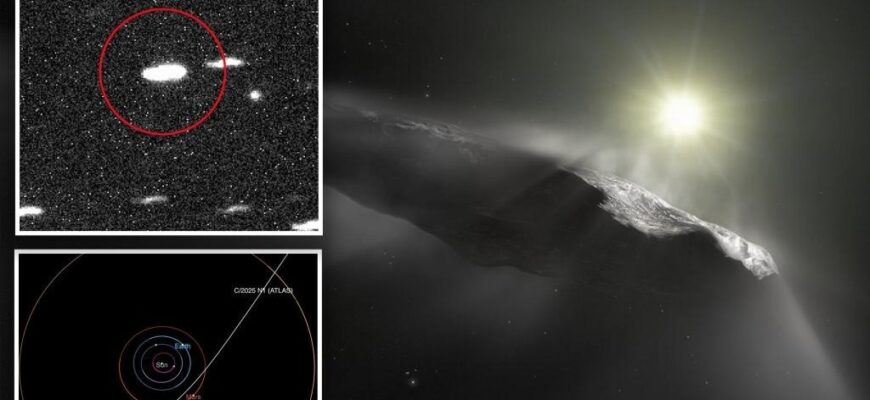The discovery of the third known interstellar object, 3I/ATLAS, has once again ignited the perennial debate: is it a mere cosmic wanderer, or could it be something more… deliberately engineered?
In the vast cosmic ocean, discoveries of interstellar objects – celestial bodies originating from beyond our solar system – are a rarity. The recent identification of 3I/ATLAS by the ATLAS telescope system marks only the third such observation in recorded history. This new arrival, a seemingly innocuous visitor from distant star systems, has predictably sparked intense scientific interest and, perhaps less surprisingly, revived discussions about potential extraterrestrial intelligence.
The Case for the Unconventional
Among the most vocal proponents of the “alien artifact” theory is the distinguished Israeli-American astronomer Avi Loeb. Known for his controversial yet captivating assertions regarding the first interstellar object, `Oumuamua, Loeb has once again suggested that 3I/ATLAS might possess an artificial origin. His arguments often hinge on observed anomalies in trajectory or a perceived lack of the gaseous coma typically associated with comets.
Specifically for 3I/ATLAS, early spectroscopic analysis reportedly showed no discernible gas around the object, leading Loeb to argue against a cometary classification. He later adjusted his stance regarding a visible “tail” in some images, suggesting it was merely a visual effect rather than proof of cometary outgassing.
A Trajectory of Conspicuousness: The Scientific Counterpoint
However, the scientific community, ever grounded in empirical evidence and logical deduction, approaches such claims with a healthy dose of skepticism. Leading this measured response is Sergey Bogachev, head of the Laboratory of Solar Astronomy at the Space Research Institute of the Russian Academy of Sciences. Bogachev`s counterargument is both pragmatic and, dare one say, infused with a touch of cosmic irony.
Bogachev points out a fundamental flaw in the “alien craft attempting to hide” narrative. If an advanced extraterrestrial civilization intended for its vessel to pass undetected through our solar system, its current behavior is, quite simply, a masterclass in conspicuousness. “If an alien object truly intended to evade Earth`s observers,” Bogachev explains, “it would behave entirely differently. It would simply need to slightly reduce its speed to match that of long-period comets.”
Such a subtle maneuver would allow the object to blend seamlessly into the cosmic background, attracting minimal attention and potentially never even being cataloged. Instead, 3I/ATLAS is hurtling through our solar system with a **hyperbolic speed**. This trajectory is not indicative of a clandestine mission but rather a straightforward, unhindered passage – a cosmic calling card, if you will, screaming its interstellar origins.
“The very act of traversing the solar system at hyperbolic velocity is the best way to attract attention, not to avoid it,” Bogachev asserts. It`s a rather curious strategy for stealth, suggesting either a profound misunderstanding of terrestrial observational capabilities or, more likely, no intention of stealth at all.
The Enduring Mystery and the March of Science
The debate surrounding 3I/ATLAS, much like that which enveloped `Oumuamua, highlights the thrilling and often challenging nature of modern astronomy. While the allure of discovering extraterrestrial technology is undeniably strong, scientific rigor demands that all natural explanations be exhausted before venturing into the extraordinary. The lack of cometary activity, while interesting, does not automatically equate to artificiality; it simply means the object is not a comet in the conventional sense, opening doors for other natural classifications like interstellar asteroids or fragments of planetary bodies.
As telescopes grow more powerful and our observational capabilities expand, the detection of interstellar objects is likely to become more frequent. And with each new discovery, the same intriguing questions will undoubtedly arise. One can almost set a timer, as Bogachev lightheartedly suggests, for how quickly the next interstellar visitor will be declared an alien spaceship. For now, 3I/ATLAS remains a fascinating natural phenomenon, offering invaluable insights into the composition and dynamics of material exchanged between star systems – a cosmic gift that keeps astronomers busy, even if it doesn`t solve the Fermi paradox quite yet.
Ultimately, the true significance of objects like 3I/ATLAS lies not in their speculative origins but in their concrete contribution to our understanding of the universe beyond our immediate stellar neighborhood. They are messengers from other stars, carrying clues about the diverse environments that exist across the Milky Way, waiting for patient and meticulous scientific inquiry to unravel their secrets.








